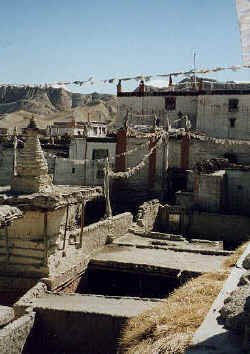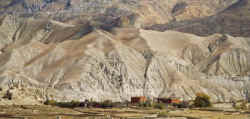MyHimalayasimpressions from |
|
|||||||
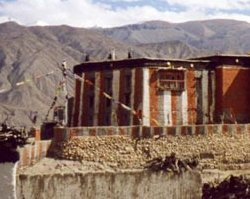
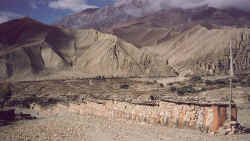
Long mani wall on the way to Tsarang.
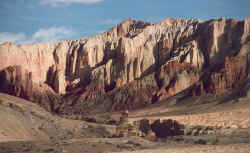
Chorten in front of the canyon before the pass.
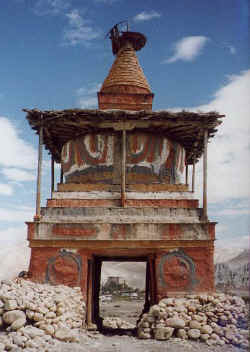
The entrance to Tsarang, the old fort has not been used for a long time and its
walls are crumbling down, nevertheless it contains a nice library, some old
statues, and even the cut-off hand with many interesting gruesome stories
attached to it.

The monastery is in a sad state, the place does not attract monks anymore.

Lo Manthang, walled capital of the kingdom.Only the three monasteries and the
king's palace are higher than the wall that surrounds the houses and narrow
alleys.
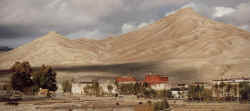
On top of the hills surrounding the city, the ancient forts of petty rulers are
stil visible.
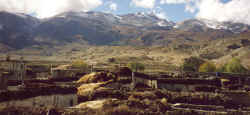
View over the roofs where firewood for the long winter is kept.
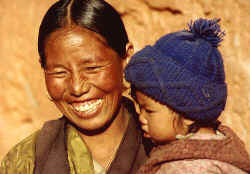
Mother and her child in Lo Manthang
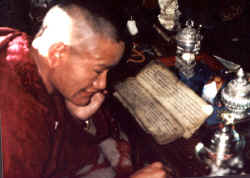
The amchi (Tibetan doctor) reading from a Tibetan text from the peh-jah.
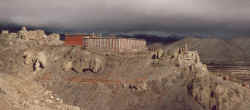
Namgyal monastery overlooking the plain.
Upper Mustang: Gemi- Tsarang - Lo Manthang
Gemi- Tsarang - Lo Manthang
Gemi - Tsarang
I’ve been thinking about whether tourism in such remote areas does the locals any good. I doubt it. We just visit and leave after two weeks, not having any idea about the influence of our trip. Maybe villagers start to think of themselves as being poor when they see us and our equipment, maybe they will try to emulate us. Of course tourism serves as a source of income but who can tell if even that is a good thing or not. On the other hand, maybe the locals cherish their culture and religion as something more precious when they see how Westerner come from far away to see their culture, their villages and monasteries. So far Mustang withstood tourism, 'our' presence doesn’t seem to change the local people and although they have some 'Western' luxuries like electric light and radios, they refrain from blindly copying our ways. Maybe tourism is not so bad after all and the expensive visa keeps the most ignorant tourists away.
Travelling in a group has advantages and disadvantages. Things are organized, you can fully enjoy yourself without having to worry about anything. But I would like to spend the next day or two in this nice place to see the festival. And I want to get to know that girl that was dancing the night before. And I am not the only one. One of the sherpas, who is already married twice, proposed to her, the kitchen crew liked her very much too, and poor Tenzing is being teased the whole time. Our companions have been dancing and drinking long after we went to bed and Sirdar Tenzi had some problems getting them to go to bed.
We leave later than usual for Tsarang, the second largest town in Upper Mustang and supposedly one of the prettiest and most interesting. Outside of Gemi we pass the longest mani wall in Mustang, not its length of 1000 feet is impressive, and the carvings are rather simple and the wall is not being extended by pilgrims adding more stones. It feels like an un-used piece of architecture, unlike the mani walls I've seen in Ladakh or even Langtang. But the fact that it harmonises so well with the scenery makes it outstanding. That is even more true for the group of chorten which stands in front of the red wall which forms the valley’s end. Architecture is simply an extension of nature, or vice versa.
When the famous Guru Rinpoche, also known as Padmasambhava, came the area he had to fight against a demon. The Buddhist teacher killed it and tore it apart, the intestines fell down where the mani wall stands, its lungs near the red cliffs just behind it and the heart at the spot of Lo Gekar, Mustang’s oldest monastery.
A steady climb takes us up a pass (3'820 m), from where a moonlike desert stretches to the horizon. Barren hills after barren hills, no vegetation or even signs of human life. Mustang looks like such an inhospitable and desolate place at first, but it is beautiful and despite the hardship people live here. They try to make their surroundings as pleasant as possible, the houses are pretty with their whitewashed walls, red pillars and black windows, the rooms are decorated and clean, flowers blossom on the balcony and the roof.
Three girls walk towards me, they are having a good time already but when they see me their laughing increases. We try to talk, and I get the impression they’re flirting and I try my best to keep up. They ask me to take a picture of them, but their courage leaves them when they see the camera. As soon as Tenzing gets here he has to translate quite a few not so serious questions concerning things like age, marriage etc. After ten minutes of laughing and chatting we go our way. At dinner we all laugh when we hear that Alexander, who walked a few minutes behind us, was also discovered as a candidate for marriage.
What has made this trek so outstanding so far were the local people. They are really friendly, not overfriendly or subservient or just friendly because they want to sell something. They are friendly, self-assured, like to laugh and enjoy smalltalk when meeting a Westerner on the way. We have a totally different background and there might be huge cultural differences (though I am not too sure about that), but they don't show. Maybe it is because the contact is superficial, maybe the understanding is deeper than that.
The chorten of Tsarang is the first sign of human presence we see. The big red-painted stupa is the centre of the scenery, further down the palace and monastery of Tsarang can be made out amid fields. It is a feast for the eye, each element by itself is already extraordinary – the massive, natural coloured chorten; the huge ruin of the old fort; the gaily striped gompa; the wind-swept plateau surrounded by hills - but the combination of it all is almost too much. A broad road leads to this second-largest village with 800 inhabitants. It's been a really short day and I feel like going on to Lo Manthang directly, but Tsarang is worth staying half a day and we camp here anyway. We have lunch in the living-room a guesthouse run by the king’s niece. Without thinking twice I clear out my tent and decide stay here for the night.
The gompa of Tsarang looks fantastic, the massive building stands on a small hill against a canyon and glaciers behind it. Several hundred monks lived here once, these days only 40 are left but of most of them don't stay in the gompa all the time. They have their families and gather at the monastery only for certain ceremonies and festivals. Traditionally the king's oldest son has become abbot of Tsarang. Today's abbot wasn't happy about this, he married early which was not liked by the common people. When his wife died early he promised to live in solitude for a few years but soon married again and left. Due to its bad reputation all brilliant monks left Tsarang for other more promising monasteries, which is even worse than the physical damage.
The building looks impressive from the outside, but the sad state it is in is easily recognisable upon entering. Nobody seems to take care of it, the building is falling down, many rooms cannot be used anymore. The assembly hall has fine paintings, statues and tangkas but they seem purposeless. I realise how big the monastery is only when I'm standing on the roof. The view is amazing, but it is sad to see a 400-year old building falling apart. The monk is really happy when I'm back down again, he was afraid the roof was going to collapse. Supposedly the old assembly hall offers more beautiful paintings, it was once famous for containing the finest art of Mustang.
The other major attraction is the king's palace. It hasn't been used for 40 years and it shows. The only two rooms that are in good condition are the Gonkhang and the chapel with fine statues and Tibetan books. Three scriptures have recently been stolen, one more sign of tourism's bad influence. The statues show the 'Three Holies', three figures who played an important part in Mustang's early history. On the floor above is the Gonkhang, the room of the protectors. Usually it contains just statues of the Dharmapalas, here we find a stuffed snow leopard, old weapons, armour and other scary artefacts. The cut-off hand gets the most attention, especially from our guides. Several stories about the hand circulate, 1. it was the hand of a thief, in earlier times cutting off the right hand was the punishment for the second offence, 2. a humble monk offered his hand as a sacrifice 3. to prevent an architect to build a similar dzong his hand was cut off. Whatever story is true, they are all good gruesome stories and leave impressions on locals’ minds.
The cook used the afternoon to prepare momos, a Tibetan version of tortellini filled with vegetables. After this great dinner I am glad that I can roll out my sleeping bag on the bench near the window instead of having to walk to our tents in the courtyard. It's warm and very comfortable, and hey, when do you get to sleep in a royal living room? It has two huge windows and a beautiful big cupboard that was brought from Tibet around 1960. The carpet on the bench is thick enough to make for a comfortable bed, yet I lie awake for a long time before falling asleep. Long after the laughter and talking of the locals next door has stopped I still hear the prayer flag flap in the wind and watch the stars through the window.
Tsarang - Lo Manthang
Luckily the king's niece owns an aristocratic little Tibetan poodle and not one of those scary Tibetan mastiffs. On my way back from the toilet in the early morning I find the dog in front of 'my' door, barking and snarling at me. I yell 'Tashi, it's ok it's me' but apparently I'm not very convincing. But at least I'm loud enough to wake up somebody who calms the dog.
The weather has changed, low-hanging dark clouds cover the sky. It's just a question of time until rain will pour down. We leave Tsarang with a group of mountain bikers, but they're rather pathetic. They can't ride their bikes uphill because it's too steep, often they can't ride them downhill either because it's too steep and it must even be hard to ride them when it is flat. Guess who carries their bikes? Yes, porters. But officially they're the first cyclists who made it to Lo Manthang. It would rather call it 'letting other people carry my mountain bike' than 'mountain biking', but actually I don't care. Their liaison officer, Krishna, has accompanied the Globotrek tour around Manaslu before and is quite cool. Our officer is rather dull and a bit rude and impolite, sometimes I feel a bit sorry because nobody likes him and he has a really hard time health- and equipment wise.
The rain gets heavier every hour, the clouds are so low that they soak up and swallow most of the scenery. Luckily the flat trail makes walking easy, but apart from a chorten and a few caves nothing draws my attention away from the rain that doesn’t seem to stop. My pants are soaking wet, rain is still increasing. I want to get to Lo Manthang fast, and poor Kami has to keep up with me. One last pass and between two rocks that form a gate there it is, Lo Manthang, capital of the Forbidden Kingdom. The view is not as stunning as I wished it to be; clouds and rain blur the scenery and quite honestly I'd rather be in Lo Manthang right now than just look at it. We walk quickly and soon reach the outer wall. I have imagined my arrival more 'glorious' and am a bit disappointed, but at the same time happy to have reached a shelter. Arriving here feels the same to me as it must have been for travellers hundreds of years ago, relieved and happy about reaching a place of comfort and security.
Lo Manthang was founded around 1450 by the son of the legendary Ame Pal, who conquered and united the small kingdoms in Upper Mustang. A high wall, 300 m long and 150 m wide in the shape of an L, has served as protection against bandits, warriors and the ferocious winds. It's never been extended, archaeologists see this as a prove that the village hasn't changed much in the last 500 years. 1'200 people live in the 140 houses which are connected by narrow alleys which go beneath houses at a few spots. It's a maze that seems really big but I always end up at a chorten or monastery or house I’ve been before. Most houses are two-storied, houses of aristocrats can be higher but by far the biggest buildings are the monasteries and the palace.
Although it is tempting after this morning’s miserable walk to relax and do nothing I spend the afternoon walking around in Lo Manthang. While exploring the alleys I realise that this little town offers so much that two days will never be enough.
A few chortens stand in front of the main gate. The first building after the gate is the big king's palace. It must about 40 feet high and is quite long, but its size makes it hard to maintain and the last earthquake left big cracks in the facade.
Monks live only in the newest of the three monasteries. I am surprised to see about 30 young monks in Chöde Lhakhang, which was founded around 200 years ago. It also represents the Sakya tradition but has rivalries with the Namgyal monastery, therefore the monastery is decorated with horizontal stripes instead of vertical ones that are more common. The monastic school teaches not only 'Buddhist' subjects but also secular ones like mathematics, Nepali or science. If the whole education is as good as their English this must be an amazing school. The small monks are very talkative, curious and eager to use their English. I'm told about a puja in the morning, 'see ya tomorrow' one says when I’m leaving. The new assembly hall doesn't seem to be quite finished, it looks empty while the old assembly hall is full of fine statues and paintings.
Even though the two other monasteries are not 'used' anymore, families take turns taking care of the gompa, changing the water every morning and lightning butter lamps in the evening - and keeping the key. While walking around Jampa Lakhang, the only buildings which is higher than the palace, the door of a nearby houses opens and a young girl sticks her head out, whom I ask for the key. She seems to know who has it this month, but somebody in the house doesn't want her to go and get it. I'm persistent and after three long minutes her father makes a gesture telling me to wait while he is getting the key.
To protect themselves from evil spirits, occupants have hung ghost traps over the small doors, decorated goat skulls with pieces of strings knotted around them. The monotonous sound of prayers comes out of a house, monks perform a ritual for a sick or deceased person.
Five minutes later another man comes and unlocks the door to the courtyard. Big wooden pillars support the roof from where we enter the towerlike building consisting of a single room which is completely dark. A huge statue, whose pedestal is further down and can't be seen, is the centre of the room. The only purpose of the whole monastery seems to hold that impressive Buddha Maitreya, the 'Buddha who is still to come'. On the walls are some of the finest mandalas I've ever seen, the details and colours are stunning. Many of the them are damaged, the face of the northern wall is totally destroyed. In Switzerland we spend millions of dollars restoring 'old' farmhouses that nobody cares about while here important cultural sites are just withering away. Admittedly the west does finance some projects and sends experts but if you look at the proportions it’s just a joke.
I don't want to wreck the poor keykeeper's whole evening so after half an hour I leave. It is dark already but finding our guesthouse is easy. It doesn't have many of them here anyway and all rooms are booked, therefore we stay in the chapel of the guesthouse. The owner has put four extra beds in it, the room is packed and we've laid out our wet clothes to dry, making a complete mess. I’m a bit uncomfortable and feel like I'm desecrating the chapel.
After lunch it looked as if it were clearing up but it's been raining the whole day. The roof has started to leak. The few tourists who were here all left because they were afraid that winter has started and snow would make passes impassable. I can imagine worse things to happen than having to spend a few weeks here, though when I really think about it a whole winter would be too long.
It’s early morning when I get up to go to the ceremony in the new monastery. Rain stopped but the clouds are still there, but at least they changed their colour from dark grey to a less threatening white. After a slippery walk I’m at the monastery shortly before 700. Three dozen cute young monks whirl around trying to be punctual, carrying cups and bowls for breakfast which is served after the puja. Age and skills are reflected in the seating arrangement, the youngest novices sit in the row left, the far right is for the most knowledgeable monks and the abbot. He gets up every 15 minutes, takes a stick and walks around to see and hear how his students are doing. The only time he uses the stick is when he pokes one monk who had his mind on other things. The row on the far left has it easy, as long as they don't disturb and wear their chuba properly the abbot is lenient. Nevertheless, whenever he passes them they become very reverential and look at him with big eyes. All the voices praying together add up to a monotonous mixture of murmuring, singing and talking. It is impressive how even the youngest monks know many texts by heart. After years of such disciplined education I'm sure the mind is capable of incredible things. The prayers are interrupted by music and periods of complete silence. Although I don't know what‘s going on exactly I am very impressed. The tourists who are watching behave reasonable and we don’t seem to disturb. Except for one of the mountainbikers who is wearing a hat the whole time. It’s really embarrassing. She comes all the way to Mustang but has never bothered to learn about the most basic customs. Such ignorance makes me angry.
After 1 1/2 hours breakfast is served, butter-tea and tsampa. The sound of the monks eating so noisily makes me feel like being in a stalactite cave, it sounds like drops dripping into a pond. We're also offered butter tea and, remembering the delicious one at Tsarang, I happily take a cup. It tastes strange, the butter seems a bit old, but as long as I don’t get sick I have no reason to complain.
Much to the relief of everybody, the sun has come out and the wind blows the last clouds away. We take the chance and set out for a short walk outside the capital. Our 10 day permit doesn't allow us to go north of Lo Manthang, to villages further up the valley where the king's summer residence is. Namgyal is also out of reach, the monastery is built on the southern edge of a broad valley. The mountains behind it are completely black due to the low, dark clouds while here the sun turns everything into a bright light. The contrast seems unreal, like an old oil-painting depicting the moments before a thunderstorm. We don't get to see Lo Manthang from its impressive northern side either, but once atop of a hill south from where we have a great view over the whole valley there's no reason to feel bitter or regretful. The landscape is so diverse that it seems like a whole puzzle of independent mini-landscapes - valleys, canyons, plains, snow-covered mountains, rivers - with Lo Manthang in its centre. 'Plains of Prayer' is a fitting name.
In the afternoon there’s more time to explore Lo Manthang. It is hard to decide where to start, the number of objects for explorations is big despite the town’s small size. The medical clinic should be worth a visit, but first I want to find out more about the new monastery and its school. One of the teachers of the monastic school is happy about visitors and shows me around (Pema Tsering, Tse Chhen Shedrubling Monastic School, Lo Manthang, Upper Mustang.) Final examinations were finished last week, holidays start the next week so Pema has time for a long and interesting conversation about his life, his education in Dharamsala, the Khampa guerrillas, today's problems of Mustang and the school. As expected, of the 70$ we pay per day for our permit, not much gets to Mustang, officially it's 60%. The view from the roof is even better than the one from our guesthouse. Three small monks join us, soon they discover that the zoom on my camera is a great toy. Pema invites me to meet the abbot, but because the Prince of Mustang is receiving us I have to leave.
First we have to buy the katas for the royal audience. After a short instruction on how to hand the kata and address the prince we walk past some terrifying Tibetan mastiffs that are chained to the wall. We have to wait for a few minutes, then we are welcomed by the heir to the throne in a nicely furnished room. The king is away visiting some areas near the Tibetan border. The prince is a nice 40-year old educated man, but he doesn't seem very eager to become king. Unlike in Western societies where men in power hang on to their positions as long as they could, the king of Mustang traditionally retired when his son was about 25 years old. But it's understandable that the prince enjoys life in Kathmandu over a rather dull one in a medieval castle. Especially if you consider that the influence of the king is decreasing. Still, whenever his father his away on travels the Prince flies to Jomosom and walks or rides to Lo Manthang in two days.
I was a bit shocked but not very surprised to hear what our liaison officer proposed for the development of Mustang: building roads and introducing modern technology. The plan of the king to build an airstrip seems even worse, simply imagine the mob of ignorant tourists flying out to look at Lo Manthang for a day, taking a few pictures and then returning to their five star hotels in Kathmandu. Luckily the government in Kathmandu didn’t allow the construction of the airstrip, the proximity to the Tibetan (Chinese) border makes it too dangerous.
I visit the last of the three monasteries, Thubchen Lhakhang, the 'Palace of the victorious Buddha Shakyamuni'. The assembly hall is huge, but more impressive is its height. I wonder what this must have felt like when 2000 monks lived in Lo Manthang and gathered in the two monasteries. Because of restoration work most statues are covered with polythene sheets or can't be seen at all, a disappointment. The sterile atmosphere is unusual and strange, it is more interesting to walk around town where there is more interaction and much more to see.
Elderly people, children and everybody else who is not busy seem to be together the whole day. In the morning they sit before the main gate enjoying the first warm sunrays, later in the afternoon I see them again at the big place in front of the king’s palace playing, laughing, talking, and arguing.
Sadly this is our second and already our last evening in Lo Manthang.
|
Summary Part 3:
Passing the longest mani wall in Mustang and a spectacular canyon of red rocks, we climb another pass and soon afterwards see the plain of Tsarang. A chorten announces the village and its old fort, the monastery looks impressive from the outside but is in a sad state. When I see the walled city of Lo Manthang I understand why Mustang is becoming such a dream destination for many tourists: with its narrow alleys and interesting monasteries it creates a very quiet and charming atmosphere. |
